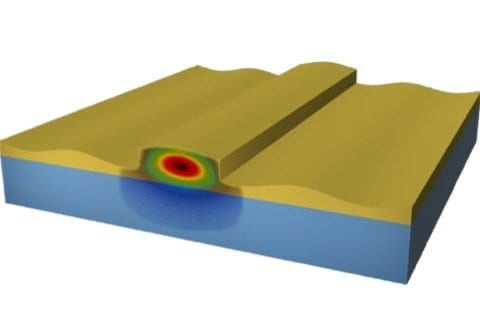
Device could improve wireless communications systems
During a thunderstorm, we all know that it is common to hear thunder after we see the lightning. That’s because sound travels much slower (768 miles per hour) than light (670,000,000 miles per hour).
Now, University of Minnesota engineering researchers have developed a chip on which both sound wave and light wave are generated and confined together so that the sound can very efficiently control the light. The novel device platform could improve wireless communications systems using optical fibers and ultimately be used for computation using quantum physics.
The research was recently published in Nature Communications, a leading research journal.
The University of Minnesota chip is made with a silicon base coated with a layer of aluminum nitride that conducts an electric change. Applying alternating electrical signal to the material causes the material to deform periodically and generate sound waves that grow on its surface, similar to earthquake waves that grow from the center of the earthquake. The technology has been widely used in cell phones and other wireless devices as microwave filters.
“Our breakthrough is to integrate optical circuits in the same layer of material with acoustic devices in order to attain extreme strong interaction between light and sound waves,” said Mo Li, assistant professor in the Department of Electrical and Computer Engineering and the lead researcher of the study.
The researchers used the state-of-the-art nanofabrication technology to make arrays of electrodes with a width of only 100 nanometers (0.00001 centimeters) to excite sound waves at an unprecedented high frequency that is higher than 10 GHz, the frequency used for satellite communications.
“What’s remarkable is that at this high frequency, the wavelength of the sound is even shorter than the wavelength of light. This is achieved for the first time on a chip,” said Semere Tadesse, a graduate student in the University of Minnesota’s School of Physics and Astronomy and the first author of the paper. “In this unprecedented regime, sound can interact with light most efficiently to achieve high-speed modulation.”
The Latest on: Sound bends light
[google_news title=”” keyword=”Sound bends light” num_posts=”10″ blurb_length=”0″ show_thumb=”left”]
via Google News
The Latest on: Sound bends light
- The Recipe For Galaxy Formation May Be Hidden In Complex Dark Matteron May 1, 2024 at 1:05 am
Dark matter appears to be more complex than we thought: a new scientific approach is trying to get to the bottom of the cold dark matter concept. The post The Recipe For Galaxy Formation May Be Hidden ...
- The Beats Solo 4 are an excellent revival of a classicon April 30, 2024 at 7:07 am
The Beats Solo 4 revive the company’s fan-favorite headphones with stronger battery life, connectivity and sound.
- Libra Compatibility: Your Best and Worst Zodiac Matches, Rankedon April 29, 2024 at 11:21 am
Let’s face it, Libras. I know you literally invented relationships. As the sign that’s all about balance, you aren’t complete unless someone is tipping your scales. You love to flirt but most of the ...
- Optical barcodes expand range of high-resolution sensoron April 26, 2024 at 11:27 am
The same geometric quirk that lets visitors murmur messages around the circular dome of the whispering gallery at St. Paul's Cathedral in London or across St. Louis Union Station's whispering arch ...
- All Sound Chakra quests in Fortnite Avatar Elementson April 25, 2024 at 7:25 am
Visit shrines of every element. Hit opponents with Firebending and Earthbending in a single match. Use Air Wheel then damage opponents within 30 seconds. Launch an opponent with Rock Wall technique ...
- Buehner: Puget Sound Convergence Zone brings sunshine, showers, rainbowson April 18, 2024 at 11:54 am
Spring is here and with it comes the mix of sunny days and days with showers alongside peak time for the Puget Sound Convergence Zone.
- ‘The sound of the earth’: new directions for an ancient instrumenton April 18, 2024 at 8:25 am
It’s a sound that is constantly shifting tone colors, like light passing in the sky through ... However, the player can partially cover holes and bend pitches to produce any pitch they want ...
- The 5 best mechanical keyboards for 2024on April 18, 2024 at 5:00 am
Here's everything you need to know before buying a mechanical keyboard, plus the best mechanical keyboards you can get right now.
- When will light rail reach Lynnwood? Sound Transit sets opening dateon April 4, 2024 at 10:41 am
Sound Transit’s light rail service will extend another 8½ ... plan was to have all Eastside trains cross Lake Washington and bend north to Lynnwood, but they’re stuck in Bellevue until ...
- The CJM’s ‘First Light’ Is a Glowing Celebration of Unpredictable Elementson January 29, 2024 at 4:00 pm
An installation view of the bending table in ‘First Light.’ (Henrik Kim ... tubes shaped to echo the missing branches and roots of an attached tree stump. A sound element uses the wood’s resonance and ...
via Bing News









